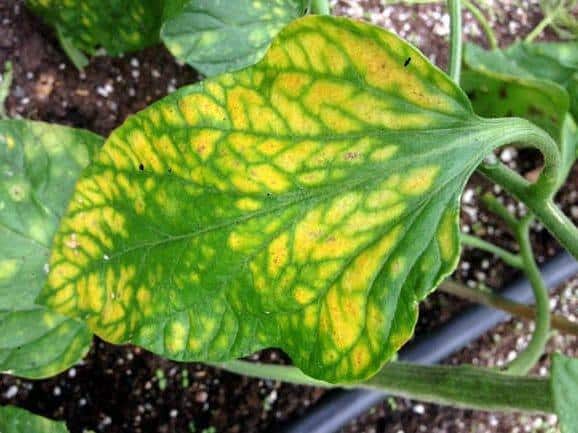A quick look at the leaves on your tomato plants will tell you if your plants need a little extra TLC. Curled leaves, brown spots, holes and purple discoloration are all signs that something is going on with your plants. Yellowing leaves may also be a cause for concern. Sometimes, it’s not a big deal — the leaves are just older ones that the plant is no longer supporting. But sometimes, yellow leaves are a sign that your plant needs help to stay healthy and keep producing. The tricky part is figuring out what exactly is going on.
Old Leaves
If the leaves on the bottom of your plants are turning uniformly yellow, it’s often just because they are old and/or not getting enough sun. As the plant bushes up and out, it directs its energy and nutrients to the new growth. As a result, older leaves don’t get the nutrients they need to stay green.
Yellowing leaves at the bottom of a tomato plant also can mean they aren’t getting enough sun. A simple fix is to prune out some of the suckers and non-fruit-bearing branches. Not only will sunlight be able to filter through the foliage better, but pruning has several other benefits including better airflow (which reduces the chance of pest and disease infestation) and bigger, more plentiful fruit (since the plant has fewer leaves to use up its energy and nutrients).
Too Much or Too Little Water
Tomato plants are picky about a lot of things, and the amount of water they receive is one of them. Watering either too much or too little can cause all kinds of problems, including yellowing leaves.
This New All-Natural Fertilizer Doubles Garden Production!
It’s difficult to provide “one size fits all” watering advice. A number of factors impact how much water tomatoes need, including average daily temperature, soil type, amount and type of mulch, the size and age of the plant, and whether the plant is in a container or in the ground. In general, however, the soil always should feel damp 1-2 inches beneath the surface. Stick your finger into the soil up to your knuckle; if the soil at the tip of your finger feels dry, your tomatoes need more water, and that could be the cause of the yellow leaves.
If the soil feels muddy and oversaturated, and the soil is normally in that condition, then the yellowing could be a sign of overwatering and, more seriously, root rot. The only way to determine if the roots are actually rotting is to uproot the plant and wash the roots so that you can see if there is any decay. If there is, trim the decayed parts off and replant the bush. Amend your soil with compost and apply mulch to improve drainage and avoid further rot.
Nutrient Deficiency
Tomatoes grow quickly and produce heavily. They need a lot of nutrients and energy to get the job done. If your soil is lacking nutrients, your tomato plants (and harvest!) will be affected. Yellowing leaves are often a sign of nutrient deficiency. Take a close look at the leaves to figure out which nutrients may be lacking.
- Uniformly yellowing leaves throughout the plant (and not just at the base) often indicate a nitrogen deficiency.
- If there are leaves at the bottom of the plant that are yellow but retain green veins, that may illustrate a potassium deficiency.
- Younger leaves at the top of the plant that are yellowing while retaining green veins point to an iron deficiency.
- If there are leaves throughout the plant that have yellow areas with dark spots inside the yellow, that may indicate a zinc deficiency.
- If only the outer edges of leaves are yellowing, your soil likely needs more magnesium.
While you can definitely add a synthetic or natural fertilizer to adjust soil nutrients, you should also test the alkalinity of your soil. Tomatoes prefer slightly acidic soil, with a pH of 6.0 to 6.8. Too much fertilizer will impact the soil’s pH level and can lead to damaged plants.
Diseases and Pests
Yellowing leaves also can be due to disease or pest infestations, but in these cases the yellowing is usually just one sign of the plant’s distress. For example, an aphid infestation may cause yellow, misshapen, and sticky leaves. Septoria leaf spot and early blight both cause brown spots on yellowing leaves. Curly top virus causes leaves to curl up and become yellow with purple veins. If your tomato plants exhibit other problems in addition to yellowing leaves, it’s best to do some research or take a couple of leaves down to your municipality’s gardening experts to help identify the cause. In most cases, diseased plants should be destroyed so that the pathogens don’t spread. But, in case it’s just a simple case of needing a watering adjustment or extra nutrients in the soil, get a second opinion before you take drastic measures.
Whether it’s an easy fix (pruning off suckers) or a harder one (uprooting plants to trim off decayed roots), yellowing leaves are a tomato plant’s “SOS signal.” By addressing the cause, you’ll improve your plant’s health. A healthier plant means a bigger harvest. And who wouldn’t want more tomatoes?
What advice would you add? Share your tips in the section below:
 Off The Grid News Better Ideas For Off The Grid Living
Off The Grid News Better Ideas For Off The Grid Living




